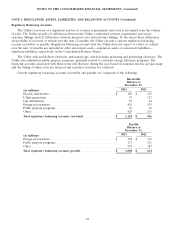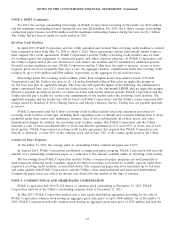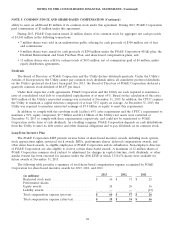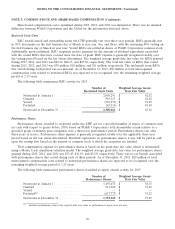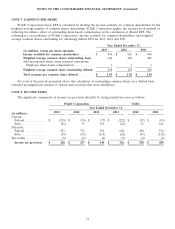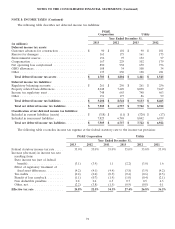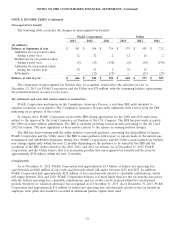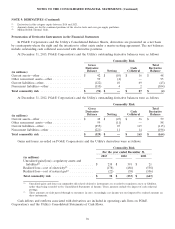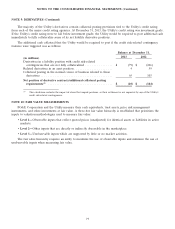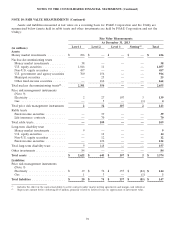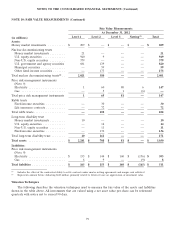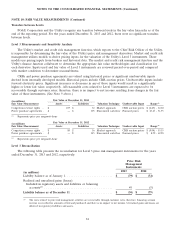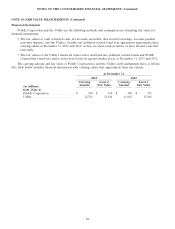PG&E 2013 Annual Report Download - page 80
Download and view the complete annual report
Please find page 80 of the 2013 PG&E annual report below. You can navigate through the pages in the report by either clicking on the pages listed below, or by using the keyword search tool below to find specific information within the annual report.NOTES TO THE CONSOLIDATED FINANCIAL STATEMENTS (Continued)
NOTE 9: DERIVATIVES
Use of Derivative Instruments
The Utility uses both derivative and non-derivative contracts in managing its customers’ exposure to commodity-
related price risk, including forward contracts, swap agreements, futures contracts, and option contracts.
These instruments are not held for speculative purposes and are subject to certain regulatory requirements.
Customer rates are designed to recover the Utility’s reasonable costs of providing services, including the costs related
to price risk management activities.
Price risk management activities that meet the definition of derivatives are recorded at fair value on the
Consolidated Balance Sheets. As long as the current ratemaking mechanism discussed above remains in place and
the Utility’s price risk management activities are carried out in accordance with CPUC directives, the Utility expects
to recover fully, in rates, all costs related to derivatives. Therefore, all unrealized gains and losses associated with the
change in fair value of these derivatives are deferred and recorded within the Utility’s regulatory assets and liabilities
on the Consolidated Balance Sheets. Net realized gains or losses on commodity derivatives are recorded in the cost
of electricity or the cost of natural gas with corresponding increases or decreases to regulatory balancing accounts for
recovery from or refund to customers.
PG&E Corporation and the Utility offset cash collateral paid or cash collateral received against the fair value
amounts recognized for derivative instruments executed with the same counterparty under a master netting
arrangement where the right of offset and the intention to offset exist.
The Utility elects the normal purchase and sale exception for eligible derivatives. Derivatives that require
physical delivery in quantities that are expected to be used by the Utility over a reasonable period in the normal
course of business, and do not contain pricing provisions unrelated to the commodity delivered are eligible for the
normal purchase and sale exception. The fair value of derivatives that are eligible for the normal purchase and sales
exception are not reflected in the Consolidated Balance Sheets at fair value, but are accounted for under the accrual
method of accounting. Therefore, expenses are recognized as incurred.
Electricity Procurement
The Utility enters into third-party power purchase agreements for electricity to meet customer needs. The
Utility’s third-party power purchase agreements are generally accounted for as leases, but certain third-party power
purchase agreements are considered derivatives. The Utility elects the normal purchase and sale exception for
eligible derivatives.
A portion of the Utility’s third-party power purchase agreements contain market-based pricing terms. In order to
reduce volatility in customer rates, the Utility may enter into financial instruments, such as futures, options, or swaps,
to effectively fix and/or cap the price of future purchases and reduce cash flow variability associated with fluctuating
electricity prices. These financial contracts are considered derivatives.
Electric Transmission Congestion Revenue Rights
The California electric transmission grid, controlled by the CAISO, is subject to transmission constraints when
there is insufficient transmission capacity to supply the market. The CAISO imposes congestion charges on market
participants to manage transmission congestion. The revenue generated from congestion charges is allocated to
holders of CRRs. CRRs allow market participants to hedge the financial risk of CAISO-imposed congestion charges
in the day-ahead market. The CAISO releases CRRs through an annual and monthly process, each of which includes
an allocation phase (in which load-serving entities, such as the Utility, are allocated CRRs at no cost based on the
customer demand or ‘‘load’’ they serve) and an auction phase (in which CRRs are priced at market and available to
all market participants). The Utility can participate in the allocation and auction phases of the annual and monthly
CRR processes. CRRs are considered derivatives.
Natural Gas Procurement (Electric Fuels Portfolio)
The Utility’s electric procurement portfolio is exposed to natural gas price risk primarily through physical natural
gas commodity purchases to fuel natural gas generating facilities, and electricity procurement contracts indexed to
74


